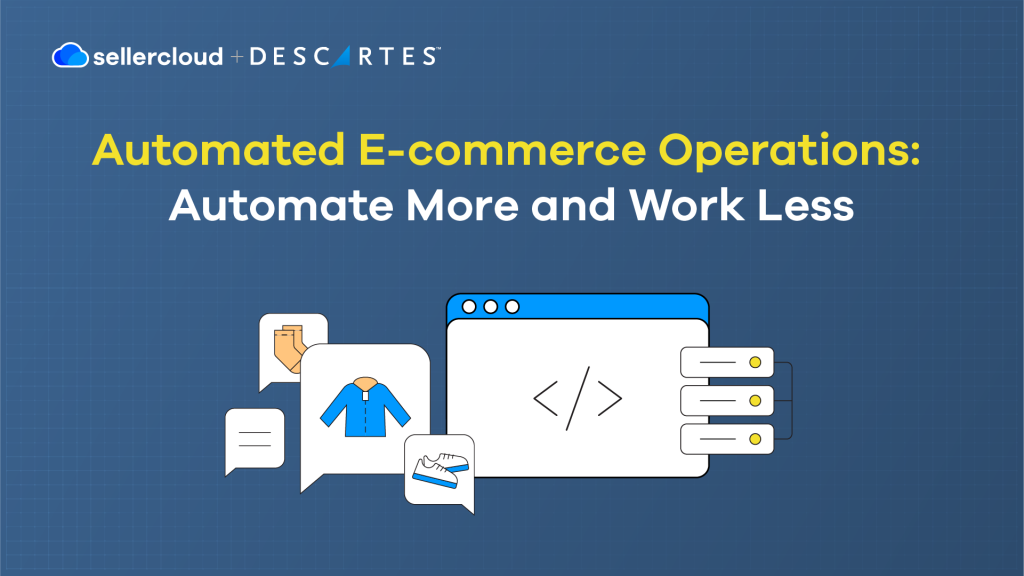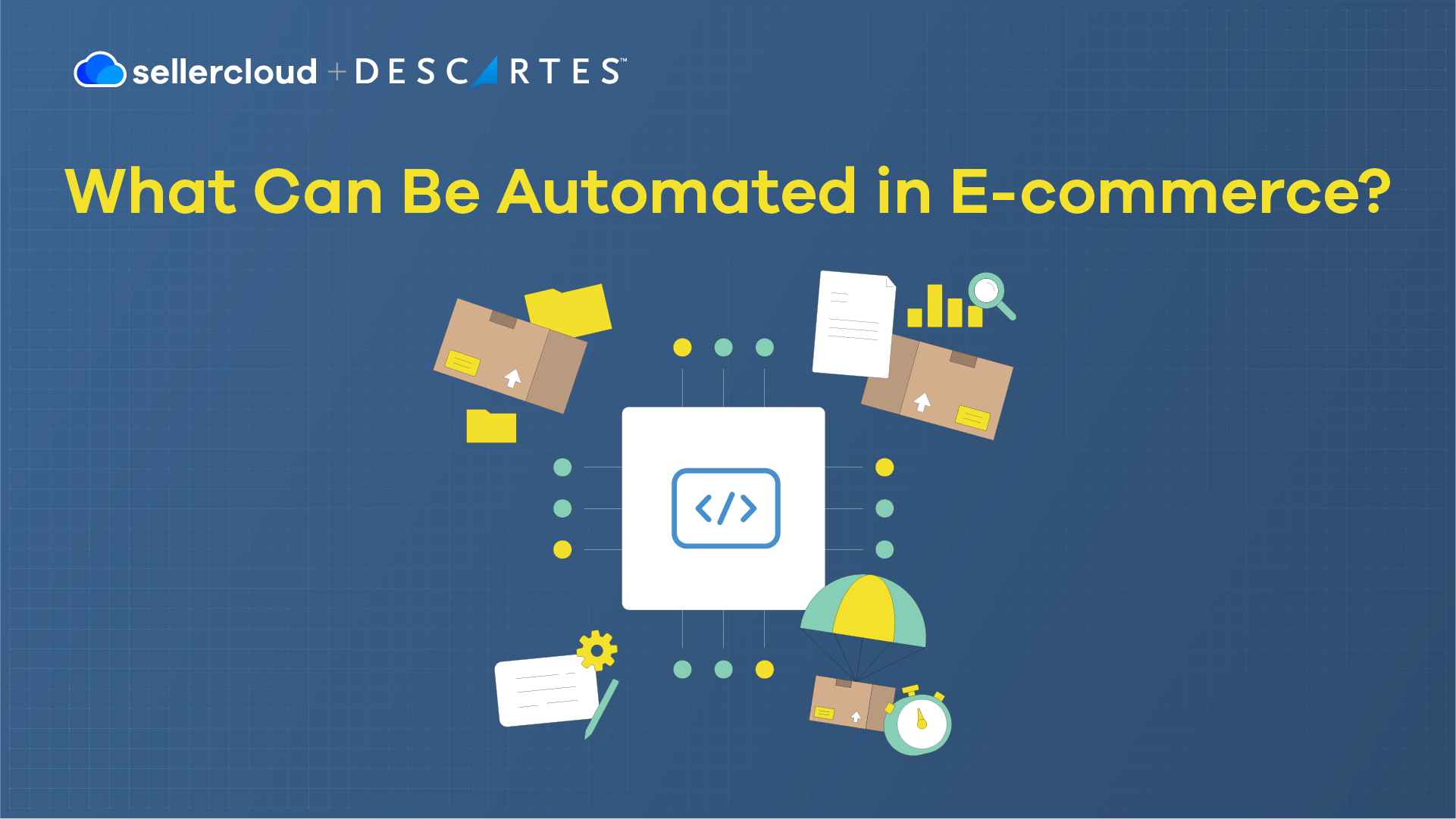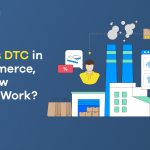
- Ecommerce automation uses software and technology to streamline repetitive tasks, helping businesses save time, reduce errors, and grow efficiently.
- Descartes Sellercloud automates essential ecommerce business tasks like inventory and order management, shipping, integrations, and much more.
For many ecommerce businesses, automation is vital for growth. Any opportunity to automate a process should be taken, and missing an opportunity to automate a process is missing a chance to cut costs and increase efficiency. According to some sources, over 70% of ecommerce businesses use some form of automation, and automating ecommerce tasks can increase ROI by up to 45%.
In this article, we explain why automation is vital to ecommerce, how automation benefits ecommerce businesses, and what areas of ecommerce can be automated.
Why Is Automation Important to Ecommerce?
There’s not much that can’t be automated in ecommerce. Ecommerce automation comes in different shapes and forms and is highly prevalent. It’s one of the most sought-after features of ecommerce solutions. Automating processes allows businesses to operate more efficiently, handle higher order volumes, and scale faster.
Automation also enhances the customer experience by ensuring quick, accurate order processing and up-to-date inventory across all channels. However, that’s just the tip of the iceberg.
What Are the Benefits of Ecommerce Automation?
The benefits of ecommerce automation are plentiful. Here are the biggest.
Less Manual Work
The most apparent benefit of ecommerce automation is that it reduces the manual work required. Any task that requires one action to follow another, information to be moved from one place to another, or an action to occur when a condition is met is ripe for automation. On top of that, employees can spend less time validating information and reduce the need for multiple people or tools to be involved in one task.
Reduce or Eliminate Human Error
Related to the above, manual work leads to human error. An easy example is orders being shipped to the wrong customer or customers receiving incorrect product variations. When people are no longer required to enter and validate information, mistakes decrease, resulting in happier customers and fewer costly mistakes.
Save Money
A direct result of speeding up processes and reducing mistakes is that your business becomes more efficient. Fewer employees can handle more work as more tasks are automated, lowering labor costs. Furthermore, using one solution to handle multiple tasks is also a form of automation. It reduces the need to pay for many services, saving your business even more money.
Ensure Compliance
Vendors and marketplaces may require that things be done a certain way. Failing to adhere to their requirements can lead to partnerships ending. For example, you may need to comply with vendors’ MAP (Minimum Advertised Price) policies, which means you cannot sell certain products under a specified price.
Ecommerce companies can create rules to prevent products from appearing on channels below that price. Descartes Sellercloud helped Pet Wish Pros and Road Entertainment with such a solution.
Allows You to Work on Other Areas of the Business
With automation taking care of so many processes, business owners can dedicate their time to other ways to grow and spend less time dealing with daily tasks. In turn, this can lead to improved profitability and help your business survive and thrive in the future.
What Can Be Automated in Ecommerce?

Businesses can automate all kinds of tasks using an ecommerce solution. Some solutions offer more automation than others or may specialize in automating specific parts of ecommerce. You don’t have to code anything unless you want to take it a step further to more advanced automation, but there are plenty of no-code software solutions in the ecommerce space.
Purchasing
Automation can notify you when you need to reorder, making forecasting demand and purchasing decisions easier. Advanced solutions, like Descartes Sellercloud, offer ‘predictive purchasing.’ Predictive purchasing takes your past sales history to help estimate how much of a product needs to be purchased and when to ensure that you have the necessary stock to meet the consumer demand with the right amount and at the right time.
Order Management
Automation can improve order management by instantly validating payments, updating inventory, and confirming orders without input. It also helps eliminate delays and reduces the likelihood of errors, such as double-selling or incorrect order information.
Automated order management can also provide real-time order tracking updates to customers and internal teams to improve transparency and customer satisfaction. Historically, businesses found themselves manually downloading order information from their sales channels and then uploading the tracking information.
With software solutions like Descartes Sellercloud, the necessary downloading and uploading are automated in real time to let your team focus on actually fulfilling the order.
Read Chapter 12 of our Order Management Guide for more on automating order management.
Order Fulfillment and Routing
Automating order fulfillment and routing ensures that orders are routed according to customer location and shipping speed requirements and, if you use multiple warehouses, based on inventory availability. Once routed, automated workflows handle everything from picking and packing to printing shipping labels, allowing for faster and more accurate fulfillment.
Automation can even assign specific carriers and calculate the most cost-effective shipping options while ensuring that the requirements of the sales channel are met. Requiring signatures for expensive item deliveries is a common practice. Many businesses utilize order automation to ensure the signature requirement is automatically added when orders meet specific criteria. This is one example of utilizing automation in order fulfillment and routing workflows.
Rate Shopping
Automation makes it significantly easier to navigate shipping rates based on size, weight, and shipping address. It enables sellers to aggregate the best shipping rates and always choose the most convenient and cost-effective.
Shipbridge is Descartes Sellercloud’s tool for rate shopping (free to use for Descartes Sellercloud subscribers). Shipping can be the largest expense for an ecommerce company. With Shipbridge, businesses can set up rules and conditions to automate their rate shopping process, ensuring that orders are delivered on time and for the cheapest rate possible.
Inventory Management
Automating inventory management starts with automatically calculating available inventory and sending that information to your sales channels. Considering every sale from every marketplace, you can automate inventory uploads regularly so that when an order comes in on one channel, available inventory is updated on your other sales channels.
It gets even more complex when considering what inventory you may store at FBA, WFS, or other 3PL providers. With the goal of ensuring you never oversell or understock, managing your inventory without reliance on humans may be one of the most vital parts of automating an ecommerce business.
Read Chapter 16 of our Inventory Management Guide for more on automating inventory management.
Catalog Management
Catalog management can be automated so you can list all your products on all your marketplaces and websites and synchronize product information. To achieve this, software solutions automate multichannel listings using ‘profile mapping’ to ensure information is formatted correctly when importing and exporting data to and from your ecommerce solution, marketplaces, or vendors.
This saves an enormous amount of manual work and ensures all the correct information is shared in the right places, without the need to do it from scratch in each place where you want to post products. Automation also helps with product variations, kits and bundles, and shadow listing tasks. These features can significantly impact your bottom line without much effort if your system automation is configured correctly.
Warehouse Management
Warehouse management can be automated with a WMS (Warehouse Management System) like Skustack, which allows you to monitor your entire warehouse and its inventory. Warehouse workers can use scanners or mobile devices to scan SKUs and collect items on a picklist, among other advanced features.
With an advanced WMS, warehouses can automate each step of their workflow, including:
- Receiving.
- Putting inventory away (even determining the right place to put inventory away to maximize space, and limit the distances required for inventory to move as it is picked or packed).
- Picking inventory.
- Packing the inventory for shipping.
- Just about every other step in between.
Warehouse Operations
Though more of a hardware solution than a software solution, using robotics for packing, sorting, and everything in between is one of the first things that comes to mind when thinking of ecommerce automation. Robots reduce the need for manual labor, speed up order fulfillment, and help businesses manage higher order volumes, improve accuracy, and lower operational costs.
There are two main types of warehouse robots:
- Automated Guided Vehicles (AGVs)—These follow fixed paths, such as tracks or magnetic strips, to transport inventory around the warehouse.
- Autonomous Mobile Robots (AMRs)—AMRs use sensors and cameras to navigate dynamically, adapting to their surroundings and optimizing routes in real time.
Fraud Prevention
Automation can flag potentially fraudulent orders so that customer services can assess them before they are fulfilled. As companies grow, the need to verify payment becomes increasingly important, and CPG.IO implemented such a solution with Descartes Sellercloud’s Order Rule Engine. If payments are verified through automation, it may take too long to verify payment information before you miss delivery deadlines set forth by the channel.
Competitive Pricing
Ecommerce businesses can use repricing tools to dynamically update prices based on competitor activity, demand, or other factors. This enables them to remain competitive and win the ‘buy box’ on marketplaces like Amazon and Walmart. Some businesses can create custom ‘stop losses,’ like Crown Display, which invested in building an automated system with Descartes Sellercloud to ensure that they can price as aggressively as needed to win the buy box without losing money on any sale.
Taking into consideration things like product cost, shipping cost, storage fees, and even the hourly wages required to pick, pack, and ship the order, Crown Display can ensure that its profit margins never turn negative.
How Can Ecommerce Businesses Automate More with Descartes Sellercloud?

A unified ecommerce solution like Descartes Sellercloud and its ecosystem is the best way to automate your operations. It is built to automate as much of the work as possible. Here are some of the many ways ecommerce sellers can automate their workload with Descartes Sellercloud.
Inventory:
- Automatically synchronizes inventory to your marketplaces.
- Reconcile inventory in FBA warehouses.
- Automatically send inventory feeds to outside partners.
- Automatically import inventory feeds from dropship vendors.
- Automatically create FBA inbound shipments based on demand planning.
Orders:
- Automatically pulls and acknowledges orders.
- Custom order rules to automatically:
- Assign warehouses.
- Split orders.
- Assign shipping carrier and service.
- Update order status.
- Add an order item.
- Automate sending dropship orders to vendors.
- Automate multichannel fulfillment with Amazon.
- Send tracking information as orders are shipped.
- Send invoices as orders are shipped.
- Automate picklist generation.
- Automatically import orders via flat file.
- Automatically pull in RMAs from marketplaces.
- Automatically reconcile order P&L with Amazon and Walmart settlement reports.
Purchasing:
- Automatically create POs based on demand planning.
- Automatically create and send dropship POs to vendors.
- Automatically sync POs to orders with presell quantity.
In addition to its suite of tools and extensive automations, Descartes Sellercloud has 350+ out-of-the-box integrated solutions, and businesses can easily connect other services via API and EDI connections to get the service they need. Furthermore, Descartes Sellercloud is highly customizable, allowing you a much greater degree of automation than other solutions, with a dedicated team working on custom requests to meet the unique needs of your business and its workflows.
Descartes Sellercloud customers can use the Order Rule Engine, which requires no support or custom development, to craft custom rules for their workflows and automate tasks in a way that works for their business requirements on a per-order, per-channel, or per-warehouse basis.
Find out how you can maximize ecommerce automation with Descartes Sellercloud. Book a demo today.
Key Points
Remember these key points.
- Automation is a significant part of ecommerce, and many businesses are looking to automate as many processes as possible to improve efficiency and gain a competitive advantage.
- Ecommerce automation has many benefits, including reducing manual work and human error, saving money, ensuring compliance, and allowing businesses to focus on growth.
- Many areas can be automated in ecommerce, from order and inventory management to rate shopping and fraud prevention.
- Descartes Sellercloud enables sellers to take automation to the next level with a wealth of omnichannel features, integrations, API, and EDI connections. It is also highly customizable.




